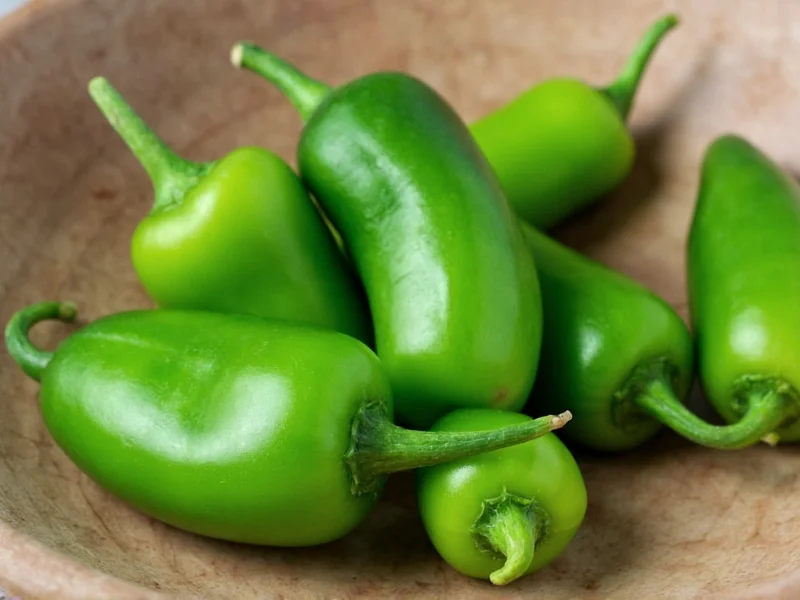Understanding exactly how much scoville is a jalapeno requires examining both the standard measurement range and the factors that cause variation in heat levels. The Scoville scale, developed by pharmacist Wilbur Scoville in 1912, measures the concentration of capsaicinoids—the compounds responsible for a pepper's heat—in Scoville Heat Units (SHU).
What the Jalapeño's Scoville Range Means
When discussing how much scoville is a jalapeno, it's important to recognize that this popular chili occupies a middle ground in the pepper heat spectrum. At its mildest (2,500 SHU), a jalapeño offers just a hint of warmth comparable to a very mild serrano. At its hottest (8,000 SHU), it approaches the lower threshold of habanero territory.
This considerable range explains why you might experience dramatically different heat levels between jalapeños from the same grocery store batch. The variation isn't random—it stems from specific biological and environmental factors.
Factors That Affect Jalapeño Heat Levels
Several elements influence where an individual jalapeño falls within the jalapeno scoville heat units range:
- Stress during growth: Peppers produce more capsaicin when stressed by drought or temperature extremes
- Ripeness: Red jalapeños (fully ripe) are typically hotter than green ones
- Seeds and membranes: The white pith and seeds contain most capsaicin
- Genetic variation: Some jalapeño varieties are bred specifically for milder or hotter profiles
- Soil composition: Mineral content affects capsaicin production
Pepper Heat Comparison Chart
| Pepper Type | Scoville Heat Units (SHU) | Relative Heat Level |
|---|---|---|
| Bell Pepper | 0 SHU | Mild |
| Jalapeño | 2,500-8,000 SHU | Medium |
| Serrano | 10,000-23,000 SHU | Hot |
| Habanero | 100,000-350,000 SHU | Very Hot |
| Ghost Pepper | 855,000-1,041,427 SHU | Extreme |
Practical Implications of Jalapeño Heat Levels
Knowing the jalapeno vs other peppers heat level helps in culinary applications. Chefs and home cooks can make informed decisions about when to use jalapeños versus milder or hotter alternatives.
For those sensitive to spice, removing the seeds and white membranes can reduce heat by up to 80% while preserving flavor. Conversely, leaving these parts intact maximizes the how hot is a jalapeno pepper experience.
The medium heat profile makes jalapeños incredibly versatile—they provide noticeable warmth without overwhelming other flavors, which explains their popularity in salsas, nachos, poppers, and countless other dishes worldwide.
Measuring Pepper Heat Today
While the original Scoville test relied on human tasters diluting pepper extract until heat was undetectable, modern laboratories use high-performance liquid chromatography (HPLC) to precisely measure capsaicinoid concentration. This scientific method provides more consistent results than the subjective human testing used in Scoville's time.
Despite these technological advances, the Scoville scale remains the standard reference for consumers and culinary professionals when discussing factors affecting jalapeno spiciness and comparing different peppers.
Using Jalapeños Based on Heat Level
Understanding the scoville scale for common peppers helps in recipe planning. When substituting peppers:
- For milder dishes: Use green jalapeños with seeds removed
- For medium heat: Use red jalapeños with some membranes
- For maximum heat: Use fully ripe red jalapeños with seeds and membranes intact
Remember that cooking can slightly reduce perceived heat, while vinegar-based preparations (like pickled jalapeños) can enhance the sensation of spiciness on the palate.
Common Misconceptions About Jalapeño Heat
Many believe that smaller jalapeños are always hotter, but size isn't a reliable indicator. The presence of stretch marks (corking) often indicates a hotter pepper, as these develop when the pepper grows rapidly under stress conditions that also increase capsaicin production.
Another common misconception is that all jalapeños from the same plant will have identical heat levels. In reality, even peppers from the same plant can vary significantly in their jalapeno heat measurement due to micro-differences in sun exposure, nutrient uptake, and other environmental factors.











 浙公网安备
33010002000092号
浙公网安备
33010002000092号 浙B2-20120091-4
浙B2-20120091-4